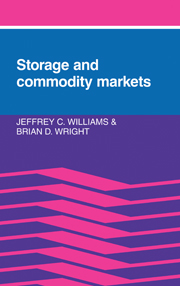Book contents
- Frontmatter
- Contents
- Preface
- Acknowledgments
- 1 Introduction
- Part I The basic model
- Part II Implications of storage for research on time series
- 6 Time-series properties due to storage
- 7 Tests of rationality
- Part III Extensions of the model
- Part IV Public interventions
- Part V Epilogue
- References
- Author index
- Subject index
6 - Time-series properties due to storage
Published online by Cambridge University Press: 03 February 2010
- Frontmatter
- Contents
- Preface
- Acknowledgments
- 1 Introduction
- Part I The basic model
- Part II Implications of storage for research on time series
- 6 Time-series properties due to storage
- 7 Tests of rationality
- Part III Extensions of the model
- Part IV Public interventions
- Part V Epilogue
- References
- Author index
- Subject index
Summary
Measured quarterly or annually, actual time series of spot prices for major commodities have two common features. First, they display considerable positive autocorrelation: Years with high prices tend to follow years with high prices and low prices to follow low prices. Second, time series of spot prices have spikes, that is, years when the price jumps abruptly to a very high level relative to its long-run average. (See Deaton and Laroque 1990.)
Perusal of the World Bank's (1989) report on commodity prices reveals numerous commodities with these two features. Spot sugar prices, shown in Figure 6.1 annually for thirty-eight years, provide a good example. The spikes dominate visually, but the tendency for the (deflated) price to remain in the doldrums for years on end, such as the stretch over the mid-1980s, is unmistakable. The first-order serial correlation of the series is 0.53. A plot for copper looks much the same as sugar. Spikes in copper prices transpired over 1973–4, 1979–80, and 1987–9, while the mid-1970s and early and mid- 1980s had prolonged low prices. The two spikes in the 1970s also occurred in other base metals, in the principal grains, and in energy products, each time heightening concern about general inflation (Cooper and Lawrence 1975; Bosworth and Lawrence 1982).
These two stylized facts about spot commodity prices are the natural result of storage. Whereas a series of spot prices for a nonstorable commodity subject to independent disturbances in harvests (and no systematic change in longrun demand or supply) would behave as pure white noise, a time series of prices for a storable commodity has an autoregressive structure, because storage spreads unusually high or low excess demand over several periods.
- Type
- Chapter
- Information
- Storage and Commodity Markets , pp. 157 - 173Publisher: Cambridge University PressPrint publication year: 1991



